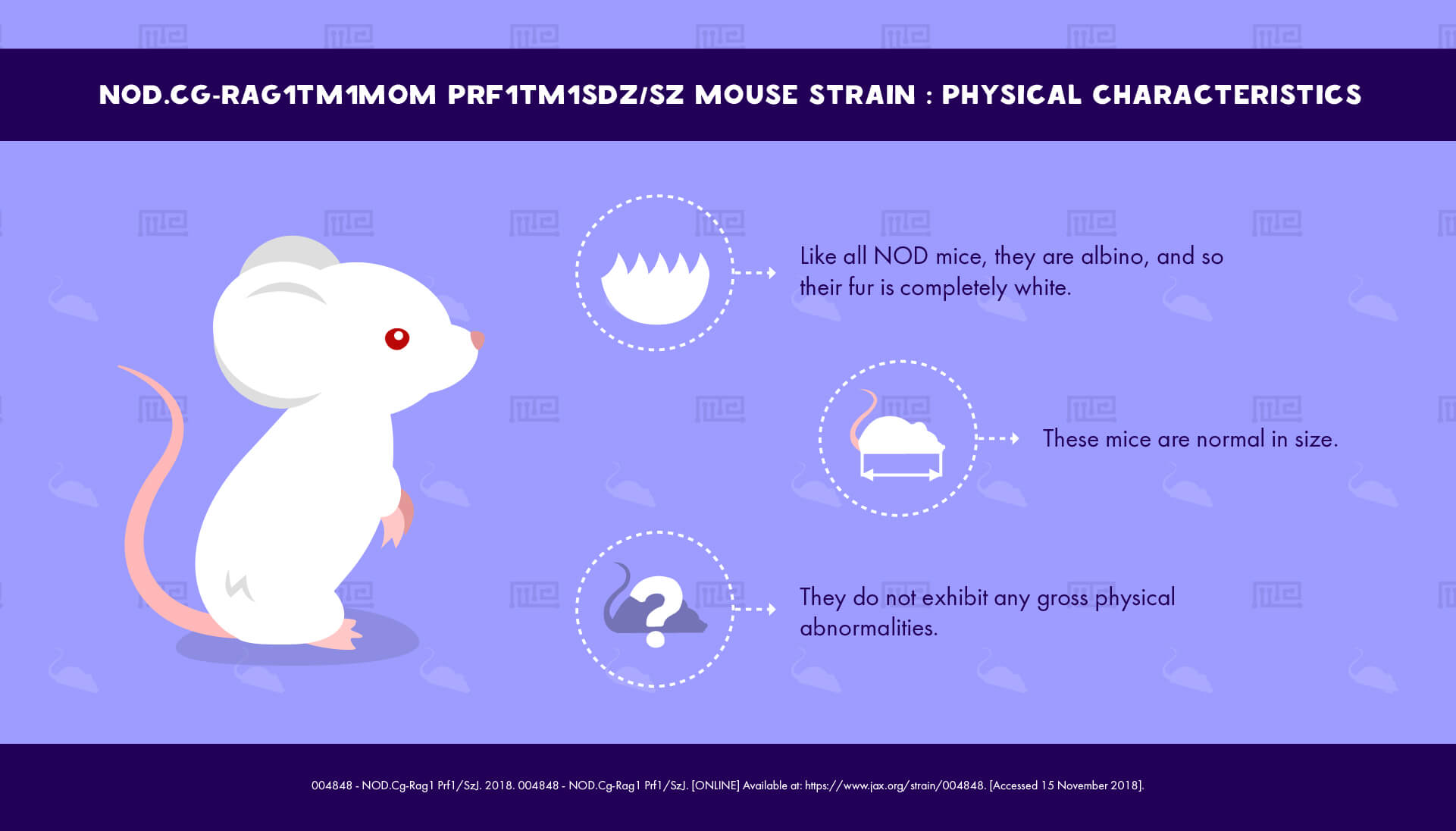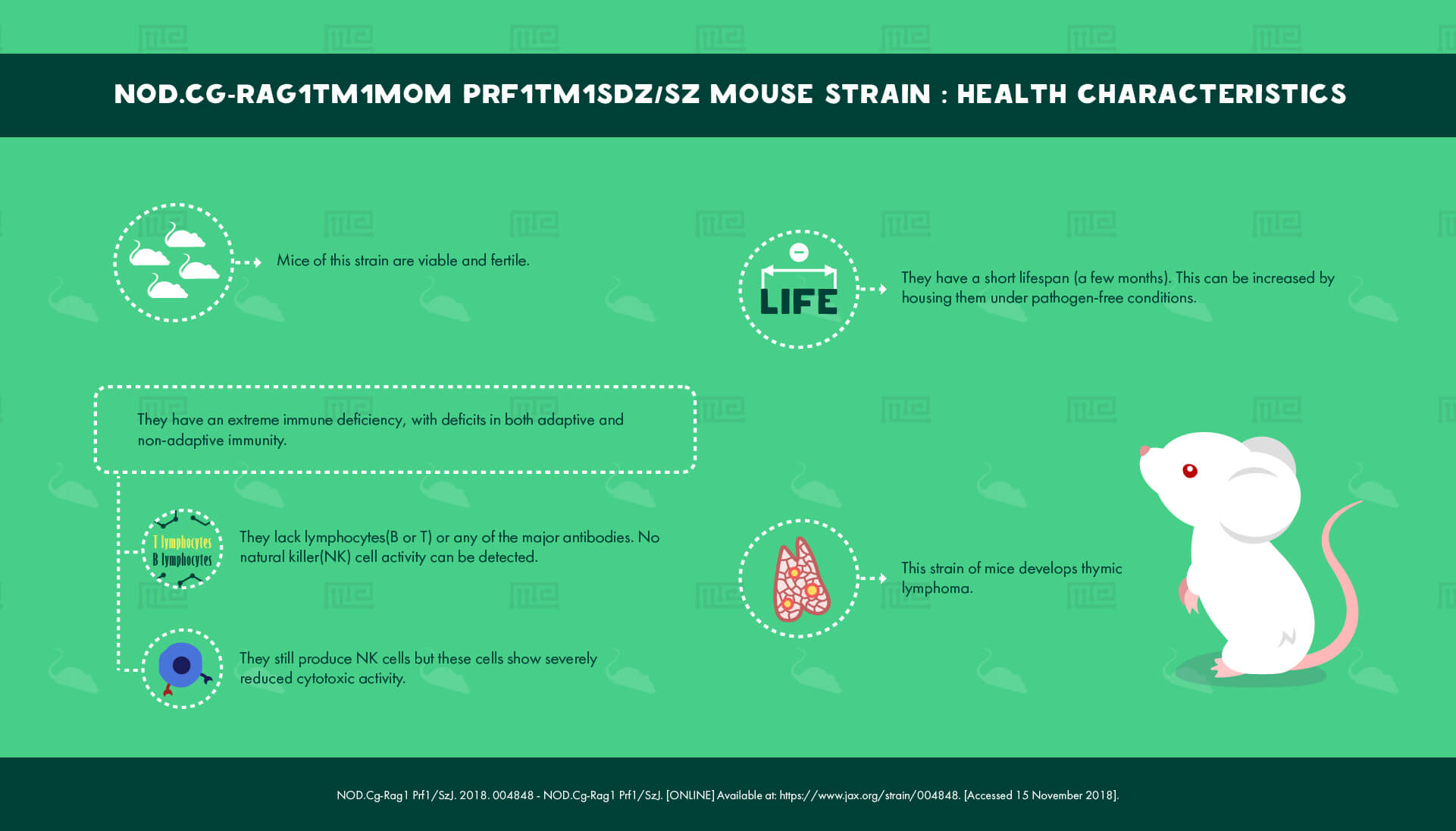Overview
NOD.Cg-Rag1tm1Mom Prf1tm1Sdz/Sz, also known as NOD/LtSz-Rag1nullPfpnull, is a form of NOD (non-obese diabetic) mouse strain that is highly immune deficient, and thus most useful for immunological research.[1]
History
NOD.Cg-Rag1tm1Mom Prf1tm1Sdz/Sz is part of the NOD group of strains, developed in Japan in 1980 from Jcl:ICR. Many different NOD mutant strains have been created from the original line.[2]
The current NOD.Cg-Rag1tm1Mom Prf1tm1Sdz/Sz strain was created by crossing a number of different mutants strains. First, a NOD.129S7(B6)-Rag1tm1Mom/J female was bred with a C57BL/6-Prf1tm1Sdz male. The heterozygous female offspring for each mutant gene were then bred with NOD.129S7(B6)-Rag1tm1Mom/J.
Finally, the mice from this round of breeding that were both Rag 1 homozygotes and Prf1 heterozygotes were crossed with NOD.129S7(B6)-Rag1tm1Mom/J for ten generations, before being crossed with one another until the final double homozygote had arisen.[1]
Physical Characteristics
These mice are of normal size and do not exhibit any gross physical abnormalities, according to the Jackson Laboratory. They are albino, like all NOD mice, and so their fur is completely white.[1]
Behavioral Characteristics & Handling
Immune-deficient strains such as this one are extremely prone to becoming infected by pathogens and developing a fatal disease. As a result, these mice should be handled as little as possible, with gloves and under sterile conditions when necessary.
The Jackson Laboratory claims that this strain does not show any major behavioral abnormalities. No studies looking at the behavior of this strain could be found in peer-reviewed literature.[1]
Health Characteristics
NOD.Cg-Rag1tm1Mom Prf1tm1Sdz/Sz mice are viable and fertile. Their most salient health characteristic is their extreme immune deficiency, with deficits in both adaptive and non-adaptive immunity.
There are no mature B or T lymphocytes present in their bloodstream, nor are any of the major antibodies to be found there, nor can natural killer (NK) cell activity be detected. This phenotype is similar to SCID (severe combined immunodeficiency).
NOD.Cg-Rag1tm1Mom Prf1tm1Sdz/Sz mice still produce NK cells (in fact, more NK cells are found in the spleen of this strain than mice with only one of two mutant genes), but these cells show severely reduced cytotoxic activity. In addition, every individual of this strain develops thymic lymphoma.
Like all immunodeficient strains, their lifespan is short (a few months), but can be maximized by housing the mice under pathogen-free conditions.[1]
Major Experimental Uses
Like all immunodeficient strains, NOD.Cg-Rag1tm1Mom Prf1tm1Sdz/Sz is especially useful in research on immune deficiency disorders (such as AIDS and SCID), autoimmunity and other immunological issues.
Compared to immune deficient strains that only show deficits in adaptive immunity (such as B6.129S7-Rag1tm1Mom/J), this strain exhibits a much more extreme deficiency, making it a better model for SCID, and a better host for xenografting experiments (used in cancer research). These mice also breed better and live longer than NOD.Cg-Prkdcscid B2mtm1Unc/J.
Downsides of choosing this strain over common alternatives include its shorter lifespan than NOD.Cg-Prkdcscid Il2rgtm1Wjl/SzJ (on account of its tendency to develop thymic lymphomas), and the fact that its full characterization is still in progress.[1][3]
References
- 004848 – NOD.Cg-Rag1 Prf1/SzJ. 2018. 004848 – NOD.Cg-Rag1 Prf1/SzJ. [ONLINE] Available at: https://www.jax.org/strain/004848. [Accessed 15 November 2018].
- 001976 – NOD/ShiLtJ. 2018. 001976 – NOD/ShiLtJ. [ONLINE] Available at: https://www.jax.org/strain/001976. [Accessed 15 November 2018].
- The Jackson Laboratory. 2018. Choosing an immunodeficient mouse model. [ONLINE] Available at: https://www.jax.org/news-and-insights/2006/march/choosing-an-immunodeficient-mouse-model. [Accessed 15 November 2018].


